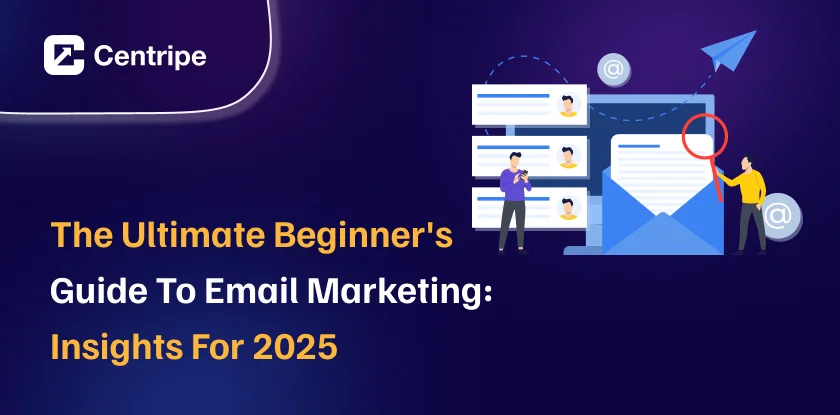Every business sends emails, welcome notes, offers, reminders, and newsletters; it’s a daily thing.
But the difference between a boring email and a money-making one? That’s where email marketing comes in.
Everyone checks email, before bed, over coffee, even during meetings. It’s part of daily life.
And no, email isn’t dead. 95% of marketers say, for every $1 marketers spend on email marketing, they receive $36% in return.
Email Marketing Definition: Understanding the Basics
Email marketing simply means sending emails to people who might be interested in your business. These emails could be about your new product, a helpful tip, a special offer, or even just a friendly update.
Some people don’t think it’s exciting and feel it’s outdated. But here’s the truth: it works really well. While everyone’s chasing the next viral trend, email keeps quietly delivering results.
In fact, 95% of marketers say it gives them the best return on investment.
What makes email marketing special is that it’s direct, personal, and cost-effective.You’re not just blasting messages to strangers. You’re building a relationship with real people, your audience, your customers, and your future buyers.
How does Email Marketing Work?
Email marketing works like this: You collect email addresses from people who are genuinely interested in what your business offers.
This can happen through website sign-up forms, popups, free downloads, or checkout pages. Once someone gives you their email, it’s your chance to start building a relationship.
Here’s the flow:
- You collect email addresses from people who are interested in what you offer (through signups, popups, or downloads). One of the smartest steps here is learning how to build an email list with people who genuinely care about your brand.
- You can email tips, offers, updates, or reminders to them that are either useful or interesting. Such emails can either be automated or manually done.
- They scan, read, and click when they like what you’re offering.
- Over time, this builds trust, and many will eventually buy from you, return again, or refer others.
Email marketing is not about spamming inboxes; it’s about sending the right message to
the right person at the right time. And when done properly, it is one of the strongest (and
inexpensive) ways of expanding your business.
Building Your Email Marketing Strategy The Right Way
Understand what you aim at before mailing any message. Concentrate on practical
outcomes such as sales, response rates, and client retention.
Having a long list means nothing, but rather having the right list. Behind popups, tools,
webinars, etc., there must be people who will care. A small and active audience will
always win over a huge and cold one.
Design your emails as though you will do it. Share useful information, make it
mobile-friendly, and write in the language of common people.
Divide your audience intelligently through email segmentation, since there is no such thing as a one-size-fits-all.
These are the basics of email marketing that drive real results.
👉 Want to learn more? Check out this related blog:
7 Innovative Email Marketing Strategy to Boost Your Results in 2025
Types of Email Marketing Campaigns
1. Welcome Emails
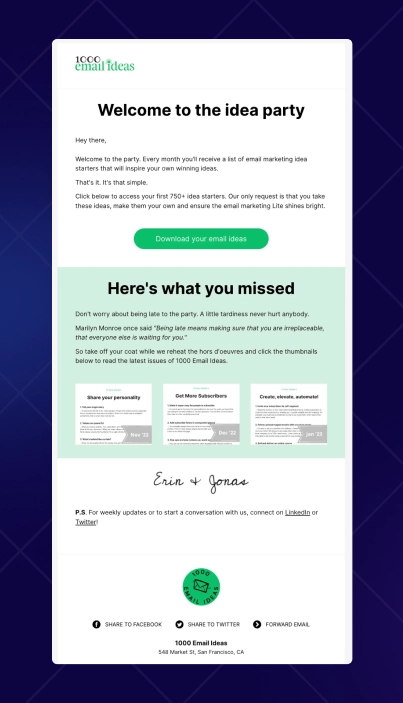
Welcome emails are important than you may have realized. The open rates are 50 per cent higher than normal campaigns, so you have to hit the mark with your first impression.
Begin by making sure the user is at the right place and that their subscription or signing-up process has been a successful one.
Then, clearly explain what your company does. Share a few helpful resources to get them started and guide them through your product or service in a simple way.
Sending a personalized email at this stage makes a big difference, it shows users you value them. Let them know they can reach a live person for help, and offer something useful right away to show you appreciate their time.
2. Lead Nurturing
B2B sales aren’t impulsive; they take time. That’s why your lead-nurturing emails should focus on educating the user about the real problems your product or service solves.
People will be able to feel the value when they can relate it to the challenges that they encounter.
Add testimonials of other businesses that have applied your solution. Through these real-life examples, it will be more convincing to them to come up with similar success.
Take it to a whole new practical level and incorporate ROI tools that would function.
As part of effective email marketing strategies, invite them to a webinar when the timing feels right, one that adds value, not just another sales pitch. Focus on building a relationship, not rushing the sale.
3. Newsletter Emails

Newsletters are effective when they are used well. To establish authority in the B2B market, you need more than just fluff.
Provide industry knowledge that your followers can not readily access on LinkedIn or any other tools.
Include company news, but make sure it’s something that matters to the reader.Highlight milestones, new launches, or changes that impact them.
Use data from real customer wins to show results and success stories with measurable value.
4. Promotional Emails
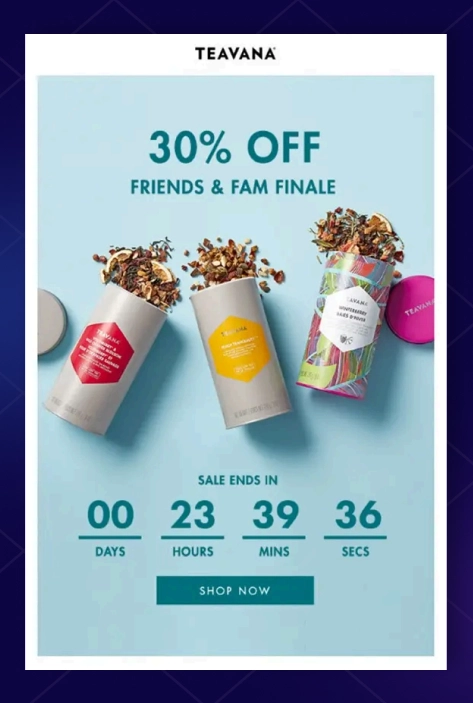
Promotional emails work well for B2b businesses if done with the right approach.
It helps you in solving real and specific customer problems by focusing on new features.Make sure all the benefits of your product and services are clearly stated without sounding promotional.
Smartly create urgency by offering limited-time trials or deals that add value. Also,highlight upgrade options that make clear business sense and improve their workflow or results.
If you’ve launched any integrations, share them in a way that shows how they’ll help.
5. Transactional Emails
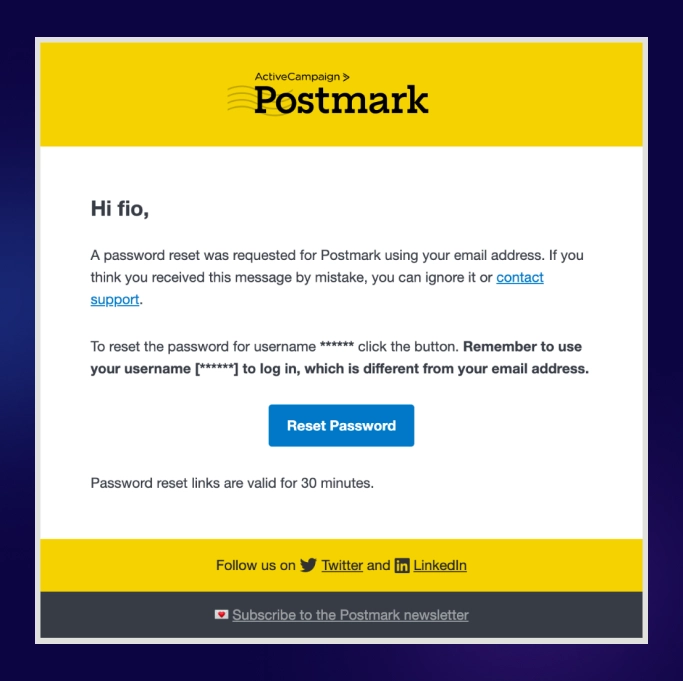
Transactional emails are good not only in the form of confirmation messages, but relatively small opportunities with the potential to make a big difference.
Start by using purchase confirmations to guide users on what they can do next or how they can get the most out of their purchase.
Sends usage reminders that also contain practical tips on how to make things perform better. e.g., show them aspects that they have yet to discover or that can make work more efficient.
6. Account-Based Marketing Emails
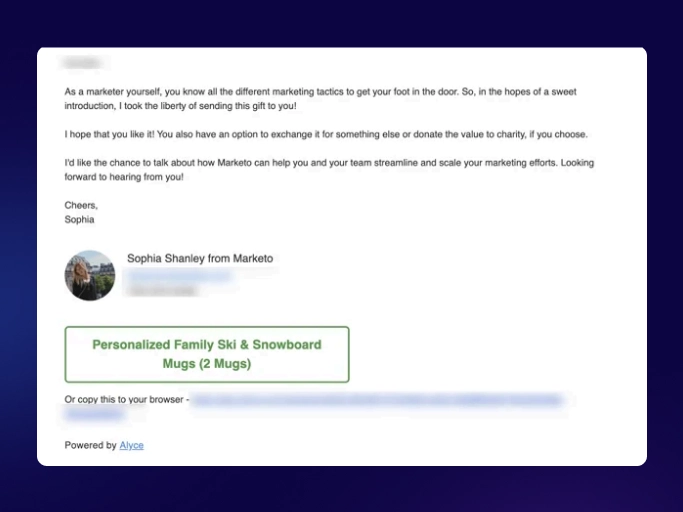
The emails used in Account-Based Marketing (ABM) must be extremely personal and strategic. One size fits all emails have become a thing of the past, and these should be made company and individual-specific.
Coordinate your messaging across different people in the company, especially decision-makers. When everyone is aligned, your outreach feels smarter and more professional.
Focus on industry-specific challenges and share solutions that directly apply to them.
Present personalized content specifically depending on them, such as individualized case studies, demos, or tips individually related to their requirements.
These are some advanced types of email marketing campaigns.
The Benefits of Email Marketing
1. You own your audience
Ownership is one of the largest email marketing advantages. Unlike social media followers who depend on a third-party platform, your email list is fully yours.
No matter whether Instagram breaks, Facebook rewrites its rules, or another platform disappears overnight, you can always communicate with your audience directly by entering their inbox.
It is a secure, dependable medium in which you have full control over, neither a rented location nor dependent on any platform.
2. All the control over the communication
The social media algorithms evolve constantly. The attention you receive one day on your content might be thousands of people, and the next day might reach very few people.
With email marketing, that guesswork disappears. You determine what, when, and to whom it gets out.
It provides you with uniform coverage and higher predictability, which is what all marketers and business owners desire.
3. Enhanced possibility of clicks and sales
Email is one of the easiest ways to get people to take action.
Not only can you announce a new product or a special offer, but you can also direct
people to a site by using email as a direct and personal means of prodding people into
clicking an offer, registering, or purchasing.
The conversion potential is huge compared to most other marketing channels.
4. Stronger relationships with your audience
In contrast to fast social media posting that disappears after a scroll, emails form a more
personal, long-lasting relationship.
After your name shows up in their inbox regularly, offering advice or other useful
information, interesting deals or specials, people start to trust your brand.
This accumulatively creates loyalty, maintains customers, and transforms single
customers into repeat customers.
5. Cost-effective measurables
One of the affordable solutions to reach many is email marketing. You will not have to
part with large sums in order to see the actual results.
And it is all quantifiable, you can trace who opened your message, the number of clicks,
and what was the most effective.
This makes it easy to improve your future campaigns and get better over time.
Email Marketing Platform Comparison
| Platform | Best For | Starting Price | Key Features |
|---|---|---|---|
| Centripe | Small–Medium Business | $99/month | Unlimited contacts, AI‑powered CRM, landing‑page builder, advanced analytics |
| Mailchimp | Small to Medium B2B Teams |
$13/month | Easy automation, drag-and-drop templates |
| Hubspot | Growing B2B Teams | $45/month | CRM integration, advanced analytics, workflows |
| Marketo | Enterprise-Level B2B | Custom pricing | Complex automation, lead scoring, ABM tools |
| Brevo | Budget-Conscious Users |
$25/month | Reliable deliverability, basic automation tools |
Choosing the best email marketing platforms depends on your business size, goals, and level of sophistication. Whether you need powerful automation, an affordable starter option, or enterprise-level features, there’s a platform designed for your needs.
Common Email Marketing Problems
Problem 1: Nobody’s opening your emails
How to fix: Your subject lines might be missing the mark. Survey your top customers,
review what competitors are doing (ethically), and focus on real customer pain points.
Problem 2: People keep unsubscribing
How to fix: Offer a preference center so users can choose what they want and how
often. There are some cases when fewer emails sent keep more people interested.
Problem 3: Sales says your leads aren’t good
How to fix: Align with sales on what defines a lead. Sit together, define lead stages
clearly, and share reports that both teams can trust. Regular check-ins help too.
Problem 4: Not enough time or resources
How to fix: Templates and email marketing automation tools can be the way to save time. Concentrate
on what drives revenue, and outsource design as required, yet maintain the main
strategy in-house.
Problem 5: Can’t prove email marketing ROI
How to fix: Set up attribution from the start. Track not only sourced leads but also
influenced the pipeline. Measure both activity and results to show real impact.
Email Marketing Best Practices
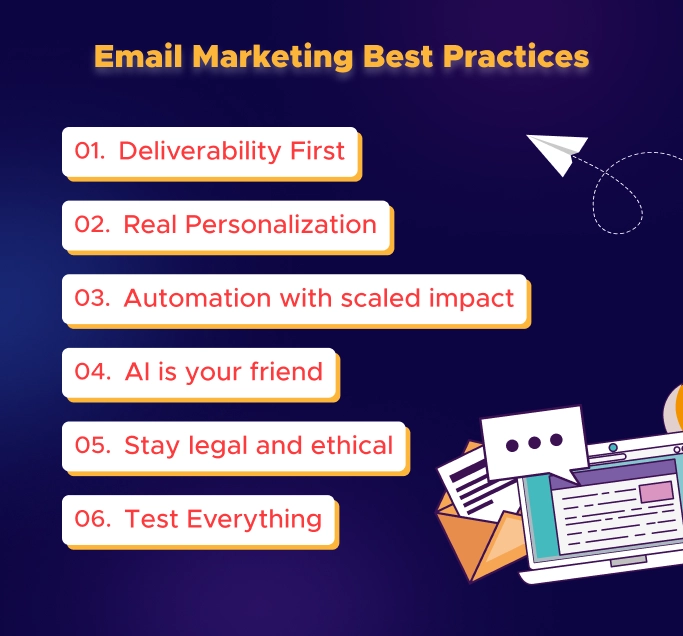
1. Deliverability First
If your emails don’t land in the inbox, nothing else matters. Focus on building trust with
inbox providers from day one. These are part of the basics of Email deliverability best practices.
- Build sender reputation slowly, there are no shortcuts
- Set up your email authentication correctly from the start
- Monitor blacklists before they start causing damage
- Clean your email list regularly
- Consider dedicated IPs for high-volume
2. Real Personalization
Personalization is not just about using a name, it makes the email feel like it was written
just for that person. It shows how email marketing works when done right.
- Reference their actual company challenges
- Mention industry events or trends that are relevant to them
- Speak directly to the pain points they experience in their specific role
- Use their engagement history smartly
- Remember past conversations and build on that context
3. Automation that scales your impact
Automation should save you time and increase results. If things are done right, it keeps
things personal while working at scale.
Lead Scoring That Sales Trusts:
- Assign points based on real company fit
- Use Behavioral scoring that reflects real engagement
- Apply negative scoring to clearly unqualified leads
- Set up automatic MQL triggers that sales rely on
Nurture Sequences That Convert:
- Create content paths tailored to each role.
- Build journeys specific to their industry
- Design workflows based on individual interests
- Launch re-engagement campaigns for inactive leads
Customer Success Automation:
- Guide Onboarding to drive real product adoption
- Send feature announcements at the right time
- Build workflows that prepare customers for renewal
- Trigger Upsell opportunities based on actual product usage
4. AI is your friend
AI isn’t here to replace marketers; it’s here to help you work smarter and make better
decisions, faster.
- Determine when people are most willing to read your emails.
- Predict the subject lines that have high chances of being effective.
- Recommend content that suits the interests of different individuals.
- Identify churn threats before they cause actual trouble.
5. Stay legal and ethical
Trust is everything. Respect your audience’s privacy and stay compliant with email
marketing laws across regions.
GDPR Musts:
- By offering transparent and clear privacy policies.
- Ensure data portability when a user requests it.
CAN-SPAM Basics:
- Always use honest and accurate “From” fields.
- Include your physical mailing address in every email.
- Make sure the unsubscribe option is easy and works with one click.
6. Test Everything
No one gets success on the first attempt. Through regular testing, you can determine
what works best for your audience.
What to Test:
- Test different combinations of subject lines and preview text.
- Experiment with various send days and times.
- Compare the long-form version and the shorter one
Metrics That Matter:
- Track open rates across different audience segments.
- Measure click-through rates based on content type
- Monitor conversion rates for each campaign.
- Keep an eye on list health over time
- Examine revenue attribution to get to know what is driving results
8-Week Email Marketing Action Plan
| Week | Main Focus | Tasks |
|---|---|---|
| Weeks 1–2 | Lay the Foundation |
|
| Weeks 3–4 | Build Your List |
|
| Weeks 5–6 | Create Content |
|
| Weeks 7–8 | Launch and Learn |
|
Case Study
EyeMail Inc., an email-technology startup, partnered with The Coca‑Cola Company in
2008 as part of a mentorship through the Georgia Minority Supplier Diversity Council
Three years later, EyeMail’s unique animated email solutions led to a fourfold increase
in revenue. Their email campaigns delivered open rates around 60% and click‑through
rates near 38%, far surpassing industry averages.
This success helped EyeMail win Microsoft as a premier supplier and expand
operations internationally: into Canada, Mexico, Pakistan, India, and the U.K.
Conclusion
The real deal is that email marketing is not dead. It is one of the simplest ways to
communicate with your customers and not pay attention to social media algorithms and
cool trends.
Email can take you through every phase of growing, whether finding leads or pleasing
customers, as long as you concentrate on creating a quality list, delivering useful
messages, and monitoring what is effective.
That’s the real power of understanding the email marketing overview.
And here’s the real secret: don’t just send emails to sell. Send them to connect. Make
them useful, respect people’s time, and tie every email back to something your business
really cares about.
